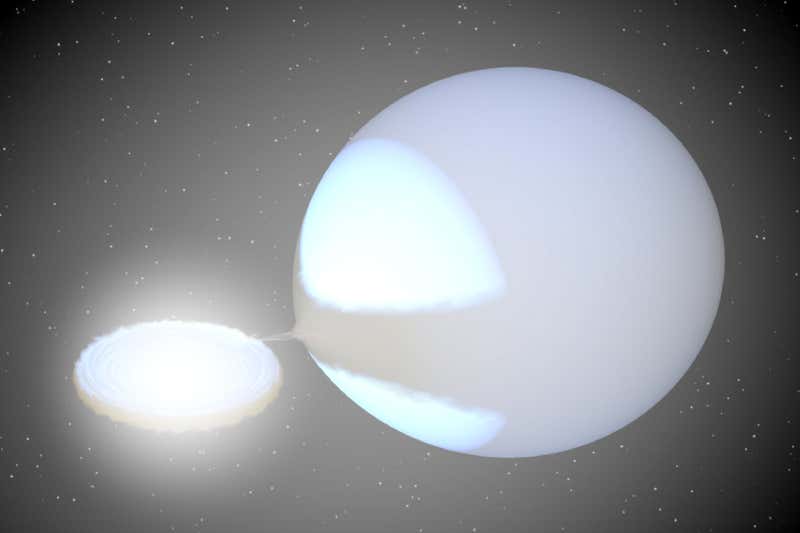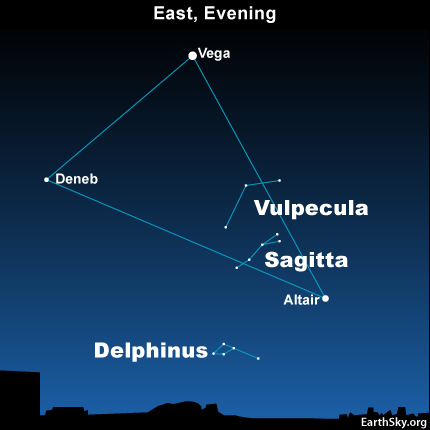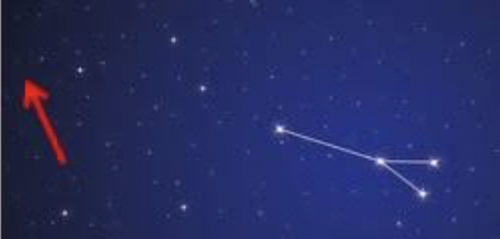

Artist’s concept of the pair of stars making up the binary system V Sagittae. According to astronomers, they’re due to merge – and shine brightly – before this century ends. Image via LSU.
The American Astronomical Society – the biggest and most established organization of professional astronomers in the United States – is meeting this week (January 4-8, 2020) in Honolulu, Hawaii. One of the more interesting stories to come from the meeting involves a faint star in our night sky. The star is V Sagittae (V Sge) – a barely visible star even in mid-sized telescopes, astronomers said – located in the direction of one of the sky’s smallest constellations, Sagitta the Arrow. This “innocent” star, they said will explode around the year 2083, becoming as bright as Sirius, brightest star in our night sky. According to astronomers Bradley E. Schaefer, Juhan Frank, and Manos Chatzopoulos, all at Louisiana State University:
During this time of eruption, V Sge will be the most luminous star in the Milky Way galaxy.
V Sagittae is what astronomers call a cataclysmic variable star. From Earth, astronomers peering through telescopes see its brightness rise and fall rapidly. Astronomers describe this rapid variability as flickering. The flickering is thought to result from the relationship between the two stars in the system, which orbit close to one another.
One star is an ordinary star, not dissimilar from our sun. The other is a small, compact white dwarf. The brightness changes take place as material from the ordinary star falls onto the white dwarf. There is a classic accretion disk (similar to that seen around black holes) around the white dwarf. Material from the ordinary star falls onto the accretion disk first, before being funneled down onto the white dwarf’s surface.
So you can imagine it: a star spilling material onto a disk around smaller, very dense star. It’s a highly dynamic natural event, which we’re viewing from a great distance. If you could see it up close, you’d surely see differently sized clumps of material moving from one star to the other, and bright spots where that material is striking the accretion disk, more bright spots where material from the disk lands on the star, and maybe some flares here and there. Some portion of all this activity is visible as rapid brightness changes – on timescales of seconds – to astronomers watching from Earth. Hence, flickering.
Plus, it’s now understood that the two stars aren’t fixed in their distance from one another. They’re spiraling toward one another, their distance constantly decreasing. What will happen? Schaefer explained:
We now have a strong prediction for the future of V Sge. Over the next few decades, the star will brighten rapidly. Around the year 2083, its accretion rate will rise catastrophically, spilling mass at incredibly high rates onto the white dwarf, with this material blazing away.
In the final days of this death-spiral, all of the mass from the companion star will fall onto the white dwarf, creating a super-massive wind from the merging star, appearing as bright as Sirius, possibly even as bright as Venus.
EarthSky 2020 moon phase calendars are available! Nearly sold out. Order now. Going fast!

The Summer Triangle isn’t a constellation but a large asterism consisting of 3 bright stars in 3 separate constellations. These stars are Vega, Deneb and Altair. If you can find the Summer Triangle, you can use it to locate 3 of the sky’s smallest constellations: Vulpecula the Fox, Delphinus the Dolphin and Sagitta the Arrow. All 3 would be impossible to see from the city, but they’re lots of fun to see in a dark sky. The binary system V Sagittae is located in the constellation Sagitta.
By definition, cataclysmic variables (CVs) are all binary stars, but they vary spectacularly in behavior. These astronomers said:
V Sge is the most extreme of all the CVs, approximately 100 times more luminous than all other known CVs, and is powering a massive stellar wind, equal to the winds of the most massive stars prior to their deaths. These two extreme properties are caused by the fact that the normal star is 3.9 times more massive than the white dwarf.
Schaefer explained:
In all other known CVs the white dwarf is more massive than the orbiting normal star, so V Sge is utterly unique.
Frank added:
Previously, astronomers have studied V Sge, realizing that it is an unusual system with extreme properties. However, no one had realized that the binary orbit was in-spiraling very fast.
This realization came from routine measures of V Sge’s brightness on old sky photos now archived at the Harvard College Observatory, providing a detailed history going back to the year 1890, these astronomers said. They explained:
Startlingly, V Sge has been systematically brightening by a factor of 10 times, and 2.5 magnitudes, from the early 1890s up until the last decade. This unprecedented behavior was confirmed with archival data collected from the database of the American Association of Variable Star Observers (AAVSO), showing V Sge brightening by nearly a factor of 10 times, 2.4 magnitudes, from 1907 until the last few years.
Frank added:
V Sge is exponentially gaining luminosity with a doubling time scale of 89 years. This brightening can only result with the rate of mass falling off the normal companion star increasing exponentially, ultimately because the binary orbit is in-spiraling rapidly.

Here is the constellation Sagitta the Arrow again, with the location of V Sagittae marked. As Schaefer commented, the Arrow is pointing to V Sagittae and the future nova. Chart via LSU.
Schaefer said:
In anticipation of this fast decaying of the orbit, the fate of V Sge is sealed. The critical and simple physics are derived from V Sge having the companion star being much more massive than the white dwarf star, so forcing the rate of mass transfer to rise exponentially. Anticipating the next few decades, V Sge will in-spiral at a rapid pace with increasing brightness. Inevitably, this in-spiral will climax with the majority of the gas in the normal star falling onto the white dwarf, all within the final weeks and days. This falling mass will release a tremendous amount of gravitational potential energy, driving a stellar wind as never before seen, and raise the system luminosity to just short of that of supernovae at peak.
This explosive event will have peak brightness over a month, with two stars merging into one star. The end result of the merger will produce a single star with a degenerate white dwarf core, a hydrogen-burning layer, surrounded by a vast gas envelope mostly of hydrogen. Schaefer said:
From this critical new input of the doubling time scale of 89 years, it becomes possible to directly calculate the future evolution of V Sge, all using standard equations describing the many physical mechanisms involved.
These astronomers used the word “robust” to describe their calculations. In other words, they are confident that the final merger of the two stars will be around the year 2083. Frank commented:
The uncertainty in this date is ±16 years, arising mostly from not having a perfect measure of the doubling time scale due to the large intrinsic jitter of the brightness in the historical record.
Therefore, the merge will be approximately between 2067 and 2099, most likely near the middle of this range.
Schaefer said:
Thus, V Sge will appear startlingly bright in the night sky. This is substantially brighter than the all-time brightest known nova (at -0.5) just over a century ago, and the last time any ‘guest star’ appeared brighter was Kepler’s Supernova in the year 1604.
Now people the world over can know that they will see a wondrous guest star shining as the brightest in the sky for a month or so, being pointed at by the Arrow just below Cygnus the Swan.
Bottom line: At the 235th meeting of the American Astronomical Society on January 4-8, 2020, astronomers said that the 2 stars in the binary star system V Sagittae are spiraling inward and due for an explosion, called a nova, which should happen around the year 2083. The nova will temporarily outshine all the stars in our Milky Way galaxy.
from EarthSky https://ift.tt/2ZYTtub


Artist’s concept of the pair of stars making up the binary system V Sagittae. According to astronomers, they’re due to merge – and shine brightly – before this century ends. Image via LSU.
The American Astronomical Society – the biggest and most established organization of professional astronomers in the United States – is meeting this week (January 4-8, 2020) in Honolulu, Hawaii. One of the more interesting stories to come from the meeting involves a faint star in our night sky. The star is V Sagittae (V Sge) – a barely visible star even in mid-sized telescopes, astronomers said – located in the direction of one of the sky’s smallest constellations, Sagitta the Arrow. This “innocent” star, they said will explode around the year 2083, becoming as bright as Sirius, brightest star in our night sky. According to astronomers Bradley E. Schaefer, Juhan Frank, and Manos Chatzopoulos, all at Louisiana State University:
During this time of eruption, V Sge will be the most luminous star in the Milky Way galaxy.
V Sagittae is what astronomers call a cataclysmic variable star. From Earth, astronomers peering through telescopes see its brightness rise and fall rapidly. Astronomers describe this rapid variability as flickering. The flickering is thought to result from the relationship between the two stars in the system, which orbit close to one another.
One star is an ordinary star, not dissimilar from our sun. The other is a small, compact white dwarf. The brightness changes take place as material from the ordinary star falls onto the white dwarf. There is a classic accretion disk (similar to that seen around black holes) around the white dwarf. Material from the ordinary star falls onto the accretion disk first, before being funneled down onto the white dwarf’s surface.
So you can imagine it: a star spilling material onto a disk around smaller, very dense star. It’s a highly dynamic natural event, which we’re viewing from a great distance. If you could see it up close, you’d surely see differently sized clumps of material moving from one star to the other, and bright spots where that material is striking the accretion disk, more bright spots where material from the disk lands on the star, and maybe some flares here and there. Some portion of all this activity is visible as rapid brightness changes – on timescales of seconds – to astronomers watching from Earth. Hence, flickering.
Plus, it’s now understood that the two stars aren’t fixed in their distance from one another. They’re spiraling toward one another, their distance constantly decreasing. What will happen? Schaefer explained:
We now have a strong prediction for the future of V Sge. Over the next few decades, the star will brighten rapidly. Around the year 2083, its accretion rate will rise catastrophically, spilling mass at incredibly high rates onto the white dwarf, with this material blazing away.
In the final days of this death-spiral, all of the mass from the companion star will fall onto the white dwarf, creating a super-massive wind from the merging star, appearing as bright as Sirius, possibly even as bright as Venus.
EarthSky 2020 moon phase calendars are available! Nearly sold out. Order now. Going fast!

The Summer Triangle isn’t a constellation but a large asterism consisting of 3 bright stars in 3 separate constellations. These stars are Vega, Deneb and Altair. If you can find the Summer Triangle, you can use it to locate 3 of the sky’s smallest constellations: Vulpecula the Fox, Delphinus the Dolphin and Sagitta the Arrow. All 3 would be impossible to see from the city, but they’re lots of fun to see in a dark sky. The binary system V Sagittae is located in the constellation Sagitta.
By definition, cataclysmic variables (CVs) are all binary stars, but they vary spectacularly in behavior. These astronomers said:
V Sge is the most extreme of all the CVs, approximately 100 times more luminous than all other known CVs, and is powering a massive stellar wind, equal to the winds of the most massive stars prior to their deaths. These two extreme properties are caused by the fact that the normal star is 3.9 times more massive than the white dwarf.
Schaefer explained:
In all other known CVs the white dwarf is more massive than the orbiting normal star, so V Sge is utterly unique.
Frank added:
Previously, astronomers have studied V Sge, realizing that it is an unusual system with extreme properties. However, no one had realized that the binary orbit was in-spiraling very fast.
This realization came from routine measures of V Sge’s brightness on old sky photos now archived at the Harvard College Observatory, providing a detailed history going back to the year 1890, these astronomers said. They explained:
Startlingly, V Sge has been systematically brightening by a factor of 10 times, and 2.5 magnitudes, from the early 1890s up until the last decade. This unprecedented behavior was confirmed with archival data collected from the database of the American Association of Variable Star Observers (AAVSO), showing V Sge brightening by nearly a factor of 10 times, 2.4 magnitudes, from 1907 until the last few years.
Frank added:
V Sge is exponentially gaining luminosity with a doubling time scale of 89 years. This brightening can only result with the rate of mass falling off the normal companion star increasing exponentially, ultimately because the binary orbit is in-spiraling rapidly.

Here is the constellation Sagitta the Arrow again, with the location of V Sagittae marked. As Schaefer commented, the Arrow is pointing to V Sagittae and the future nova. Chart via LSU.
Schaefer said:
In anticipation of this fast decaying of the orbit, the fate of V Sge is sealed. The critical and simple physics are derived from V Sge having the companion star being much more massive than the white dwarf star, so forcing the rate of mass transfer to rise exponentially. Anticipating the next few decades, V Sge will in-spiral at a rapid pace with increasing brightness. Inevitably, this in-spiral will climax with the majority of the gas in the normal star falling onto the white dwarf, all within the final weeks and days. This falling mass will release a tremendous amount of gravitational potential energy, driving a stellar wind as never before seen, and raise the system luminosity to just short of that of supernovae at peak.
This explosive event will have peak brightness over a month, with two stars merging into one star. The end result of the merger will produce a single star with a degenerate white dwarf core, a hydrogen-burning layer, surrounded by a vast gas envelope mostly of hydrogen. Schaefer said:
From this critical new input of the doubling time scale of 89 years, it becomes possible to directly calculate the future evolution of V Sge, all using standard equations describing the many physical mechanisms involved.
These astronomers used the word “robust” to describe their calculations. In other words, they are confident that the final merger of the two stars will be around the year 2083. Frank commented:
The uncertainty in this date is ±16 years, arising mostly from not having a perfect measure of the doubling time scale due to the large intrinsic jitter of the brightness in the historical record.
Therefore, the merge will be approximately between 2067 and 2099, most likely near the middle of this range.
Schaefer said:
Thus, V Sge will appear startlingly bright in the night sky. This is substantially brighter than the all-time brightest known nova (at -0.5) just over a century ago, and the last time any ‘guest star’ appeared brighter was Kepler’s Supernova in the year 1604.
Now people the world over can know that they will see a wondrous guest star shining as the brightest in the sky for a month or so, being pointed at by the Arrow just below Cygnus the Swan.
Bottom line: At the 235th meeting of the American Astronomical Society on January 4-8, 2020, astronomers said that the 2 stars in the binary star system V Sagittae are spiraling inward and due for an explosion, called a nova, which should happen around the year 2083. The nova will temporarily outshine all the stars in our Milky Way galaxy.
from EarthSky https://ift.tt/2ZYTtub

Aucun commentaire:
Enregistrer un commentaire